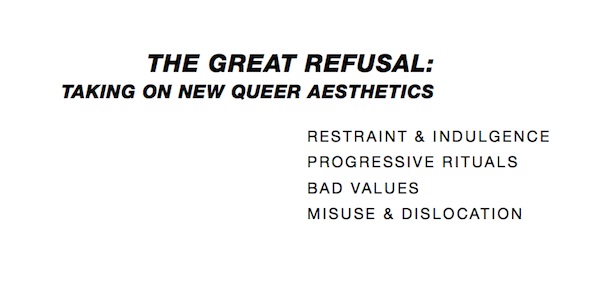Interpreting Progressive Rituals of a New Queer Aesthetics
Queer time follows its own rules, building around location, movement and identification. Adulthood, responsibility and other aspects of the “mature” self as defined by a normative time do not exist as such in queer time. Adolescence may be revisited, re-experienced and revised. Family is a combination of biological and chosen. Mid-life crises may happen at age 25—or even sooner. In queer time, there are no fixed delineators. The individual defines their own world and, as such, creates their own queer religion much in the vein of Jean Genet’s fictional yet autobiographical work, The Thief’s Journal. It is within this context of a queer time and place that we encounter progressive ritual.
Rituals typically involve some aspect of community-oriented or religious ceremony. Take a Native American pipe ceremony, which is used for connecting the physical and spiritual worlds. On a more mundane level, familiar rituals may simply be behaviors that ease anxiety or, over time, become meaningful obsessive behavior that hold importance to the maker. A man obsessively locks and unlocks his door three times before leaving his home. This is a ritual. Public worships, which could include prayer, fasting or charity, also qualify as ritual. How does one queer a ritual?
The works included in the Progressive Rituals section of “The Great Refusal: Taking on New Queer Aesthetics” consider the ritualistic practices of queer sex and sexuality through the interplay of objects and bodies. Whips and paddles typically used in gay leather culture are embroidered and stripped of their aggressive nature, thus transforming them into highly fetishized, almost ornamental objects. The process of transforming these objects becomes a ritualistic act for the artist who makes them. In another piece, magic practices take on a queer edge when mixed with blood and semen. And there is an obsessive, ritualistic practice to the writing of pornographic poetry and scroll-like writings, which are also seen in this portion of the exhibition.
Each art object, performance or image in Progressive Rituals acts as a marker of queer ritual within the context of evolving identities, personhood and the larger community. The artists here create a shared queer ritual experience that is used to transcend and transform aspects of the everyday into heightened aspects of sexualized queer practice.
—Alicia Eler
Download the PDF of Alicia Eler’s essay here: ProgressiveRituals Essay-NewQueerAesthetics-AliciaEler





